To my surprise, there are still figures that were released as tie-ins with the original Jurassic Park film in 1993 that lack reviews here, including the die-cast metal dinosaurs line by Kenner, who of course made the main action-figure line for the film as well. The metal figures were released in two-packs that contained a collector’s card for each dinosaur, similar to the main line, but I unfortunately don’t think I have the cards any more. All the figures stood on a base (part of the same metal), with Jurassic Park written in relief at the front and a notch for holding up the card at the back. The back of the original packages advertised them as “highly decorated, colorful and realistic”, which is more or less true.
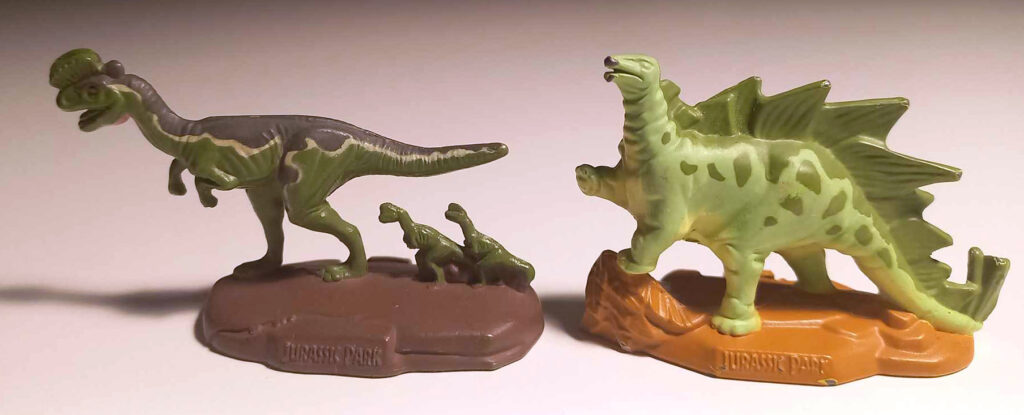
The line included dinosaurs from the film that largely looked like their on-screen counterparts with their inherent inaccuracies, but also some that did not feature in the film. Interestingly, that includes the Ceratosaurus that came with the Triceratops, and had a color-scheme very similar to what ended up in Jurassic Park III many years later. Ironically, the Triceratops was bright green, which does not exactly match the film, and other dinosaurs featured in the film have the same issue. Perhaps reflecting early concept art that the toymakers had to use as reference before the designs were finalized? This review will focus on the two-pack that included Dilophosaurus, which was featured in the film, and Stegosaurus, which was not, but was included in the sequel The Lost World. Incidentally, both are from the Jurassic Period, unlike most of the other dinosaurs of the film (except Brachiosaurus), which were Cretaceous.
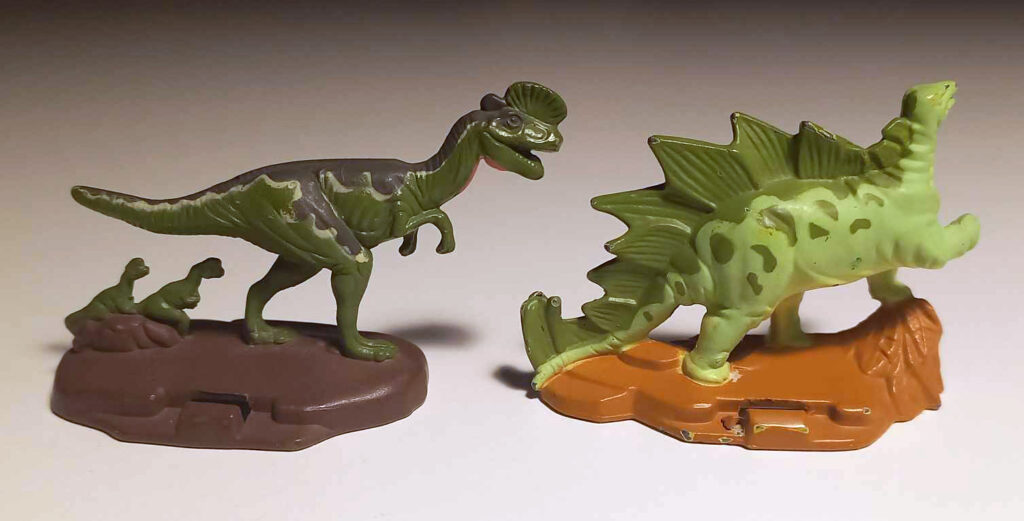
We’ll start with the Dilophosaurus, which is quite similar to how it appears in the film in both shape and coloration, though with some notable differences. It measures 7 cm from snout to back of the base, is 4 cm tall at the top of the crests, and is posed mid-stride. The first thing one notices is that it has what appears to be a pair of juveniles running after it, while all the other figures of the line seem to have been solitary. Why this choice was made is hard to say, as it doesn’t reflect anything in the film, and isn’t mentioned on the package. Since their crests are a bit more frontwards projecting, I speculated they might even be oviraptorids instead, but that’s probably not the case, as they otherwise have the same green colour as the adult. One wonders why juveniles would be depicted with supposed display features as proportionally large as those of an adult, but that’s a general problem with dinosaur depictions in popular media.
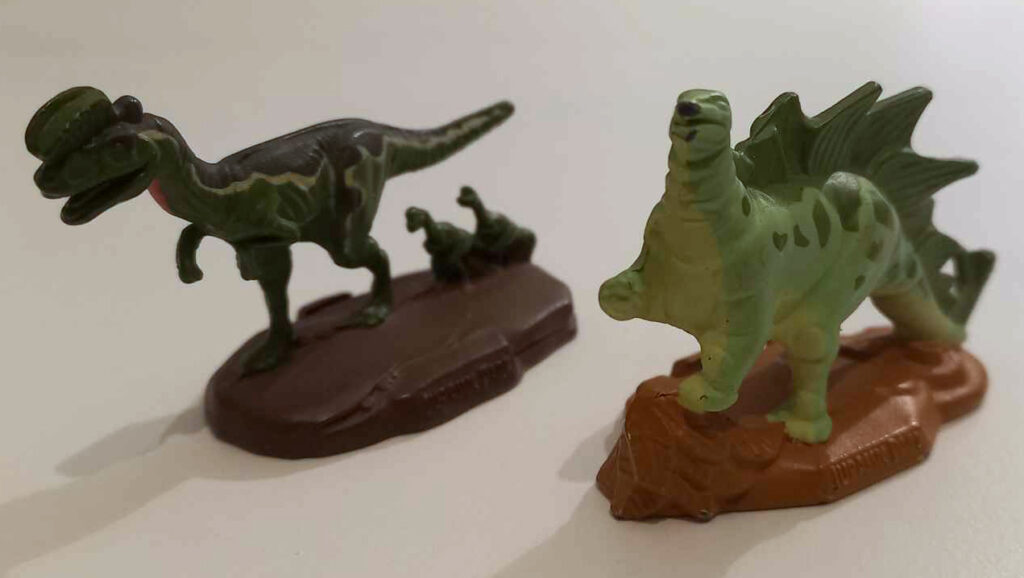
Like the film version, and unlike the real-life dinosaur, the skull is rather boxy and generically “theropody” apart from the crests, whereas in reality the skull was much more slender, with a distinct notch at the front of the upper jaw. The tail seems to be proportionally much shorter than the real life and film-versions, perhaps to avoid breakage. One hand of my die-cast Gallimimus has snapped off, so being made from metal doesn’t save them from wear. The crest-shape also overall matches that shown in the film in side-view, and how it was thought to have looked at the time, though it projects a bit more forwards. Probably also to prevent breakage, the crests are paired into a single shape, unlike the V-shape they would actually have made when seen from the front, which the film design retained. Unfortunately, the crests are also asymmetrical, the right crest being significantly taller than the left.
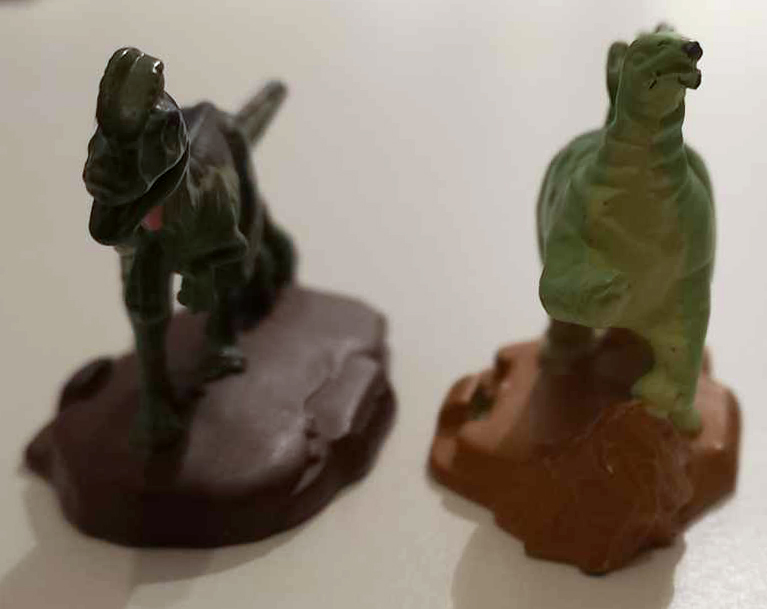
When it comes to color, it generally looks like the film-version, mainly being darker army green above and lighter, brighter army green below, with an almost white line separating the two, but interestingly, the pattern is more similar to the spitting Kenner main toy, with its curvy separation-line, than the main electronic version, whose underside is entirely white and the border between the upper and underpart color is more jagged. The metal version differs from both in not having any of the light coloration on the crests, but is similar to the electronic version in having a pinkish patch on the throat area, which I’m unsure if is present even in the film. The base is a reddish dark brown, but its underside seems to be the same green as the dinosaur’s underparts.
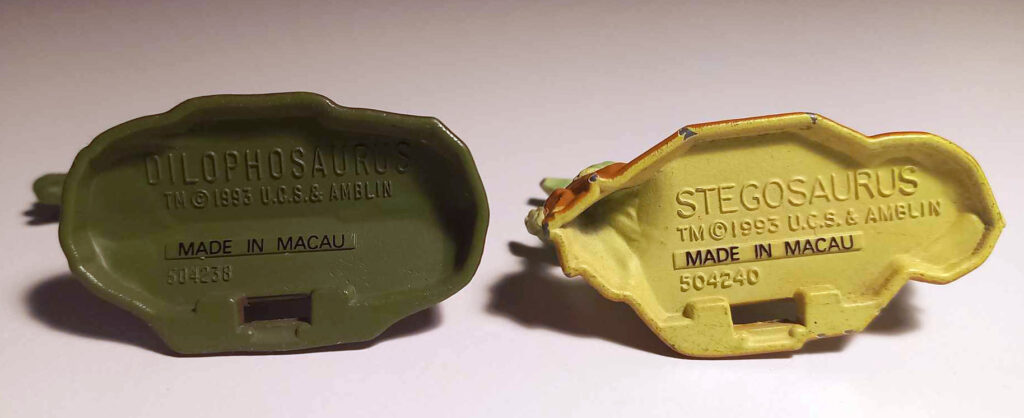
On to the Stegosaurus, which has its own interesting quirks. As it did not appear in the first film, it is extremely different from how it ended up being depicted in the sequels, since I assume Kenner had to make up their own design. But it also seems they had consistent designs across toy-lines, because the metal figure has almost exactly the same color-scheme as their main line Stegosaurus, and shares some other features with it, but also has differences. It measures 5.7 cm from the front of the base to the tip of the tail, 4 cm to the top of the head, and is posed with one foreleg lifted, the other on a rock (which seems to consist of mis-painted leaves), and the tail dragging. The base is generally more detailed than that of the Dilophosaurus, indicating a more rugged terrain.
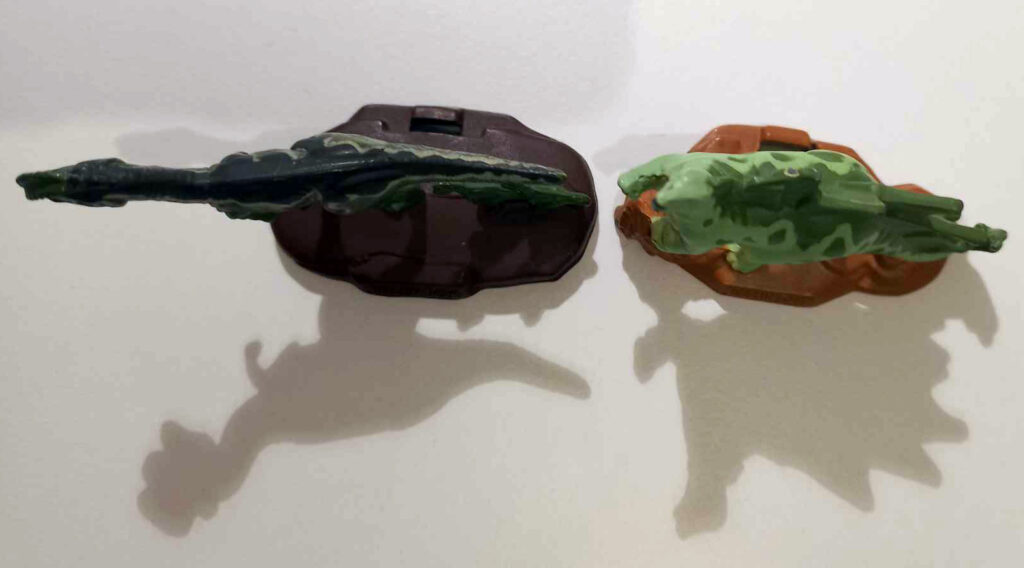
Similar to the main line version, the back-plates are very large and much more angular than the design that showed up in The Lost World. Whether this reflects a difference in what Stegosaurus species was depicted (S. stenops vs. S. ungulatus?) or simply different ways of restoring the keratinous covering is unclear, but as was pointed out in a comment for the main version and by the Dinogoss blog, the Kenner design was inspired by illustrations by Stephen Czerkas, who restored Stegosaurus plates with significant keratin extensions, and in the case of the main toy, in a single row. Oddly enough, the metal version shows the plates in alternating rows, which also seems to be the current consensus. While the tail-spikes are joined into a single, very vertical blob, there do seem to be at least three of them, whereas the main toy only has two tail-spikes in a single line, and very back-swept in comparison.

The two versions share some heavy wrinkles and saggy skin in the exact same places, notably the neck, base of the tail and limbs, and as mentioned before, the striking color-pattern is almost exactly the same. One wonders if this consistency might reflect that Stan Winston Studios actually did make designs for Stegosaurus at an early stage that remained unused in the film, but leaked into the toys? After all, it was a sick Stegosaurus in the Jurassic Park novel rather than the Triceratops that ended up in the film… Likewise, the original Kenner Pteranodon action-figure and metal figure also have the same color-pattern.

The back-plates and “thagomizer” tail-spikes are a light green, as are some spots and back pattern similar to those of a giraffe that runs across the upper side, but the rest is a creamy, very light green, and the lower parts even seem to be white (that last feature seems to have been taken further here than in the main toy). The base is ochre, while its underside seems to be as white as that of the dinosaur. While the design Kenner used for their Stegosaurus toys was generally more inaccurate, I actually think I prefer their color-scheme over the drab, sandy brown of The Lost World. Stegosaurus is one of the few dinosaurs that has historically been depicted with boldly coloured plates even when drab green and brown was the norm, and then that’s all we got from the film?!
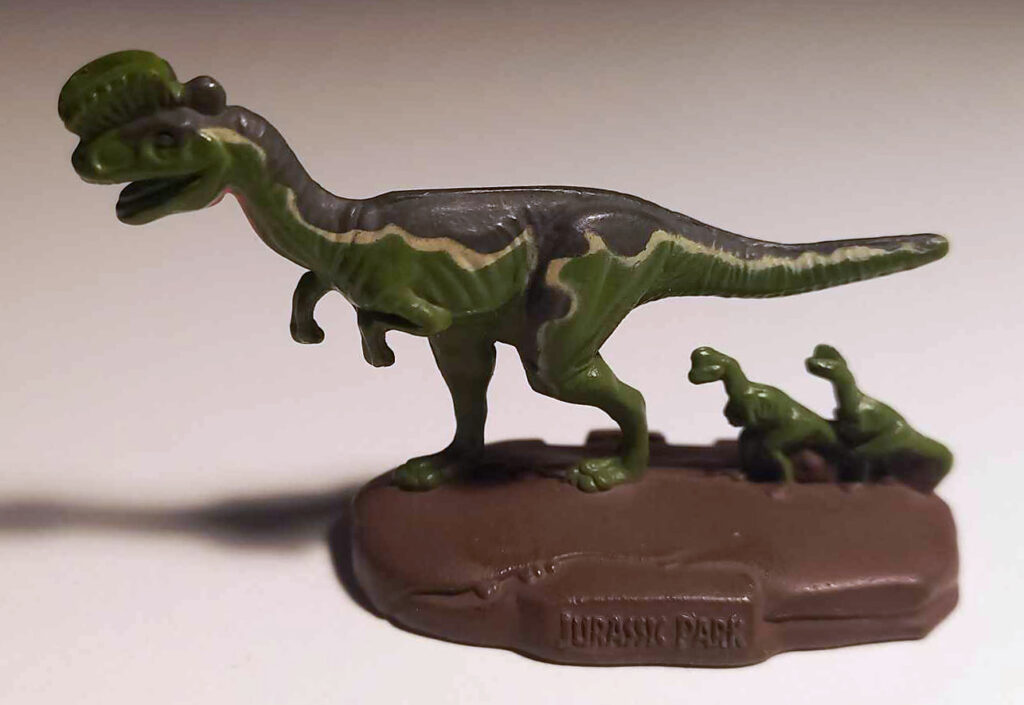
In general, the figures are somewhat sloppily painted in areas, but I think they look quite good, though it’s a shame that none of the figures of the line seem to have had individually colored eyes, teeth, or claws, which just have the same color as the surrounding skin. The paint also seems to have worn off in places, especially noticeable on the snout of my Stegosaurus, but that’s probably inevitable considering how haphazardly they were stored. Overall, I think these are very interesting figures that both reflect the designs of the films well, while also having interesting quirks of their own, and I hope the rest of them will be reviewed here.
Disclaimer: links to Ebay and Amazon on the DinoToyBlog are affiliate links, so we make a small commission if you use them. Thanks for supporting us!




The Ceratosaurus should have had a blue body. Best we got was a gray one with a red head.
I have a long, turbulent history with these things. I love them though. I own them all and then more, sprinkled around the house as they tended to come in lots when I was doing the re-homing operation a few years back. I’m staring at one right now.
@dinotoyblog What was the rehoming operation?
Remote Reply
Original Comment URL
Your Profile
I’m glad that you mentioned the Ceratosaurus. It’s one of the best examples of Kenner’s uncanny ability to inadvertently predict what would feature in subsequent Jurassic Park films. Other examples would be the Jeep with the seat that extends out to the side, the genetic hybrid dinosaurs, and Fallen Kingdom’s second Carnotaurus color scheme. Heck, even their cancelled Gulper T. rex had the wattle on its throat that later appeared on the male in the second film, so much so that they repurposed the Gulper as their male T. rex toy for The Lost World’s toy line.
Mattel is great and all, but Kenner could predict the future.
Pretty sure that a lot Dinosaurs in later Jurassic movies are inspired by the Kenner line.
@dinotoyblog I have the whole set of these including the cards. I always loved them and the Jurassic Park world-building associated with them.
Remote Reply
Original Comment URL
Your Profile
I have debated collecting these on and off for many years. If I did collect them I would want the beautifully illustrated cards too, which means probably having to buy them in packages that I would then be hesitant to open. On the other hand, buying them loose would mean having to live with the paint rub off that they’re guaranteed to have. A conundrum. In any case, I’m happy to see some of them finally make it onto the blog, it is long overdue.